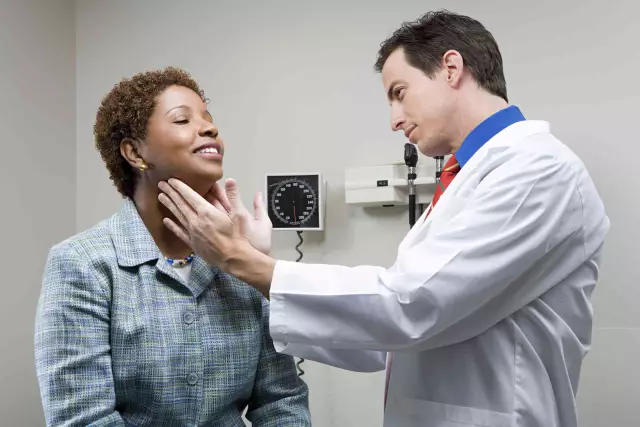- Author Rachel Wainwright [email protected].
- Public 2023-12-15 07:39.
- Last modified 2025-11-02 20:14.
Angina Simanovsky-Plaut-Vincent
The content of the article:
- Causes and risk factors
- Symptoms
- Diagnostics
- Treatment
- Possible complications and consequences
- Forecast
- Prevention
Angina Simanovsky-Plaut-Vincent (tonsillitis ulcerative necrotic, tonsillitis ulcerative membranous) is an infectious disease that affects the adenoid and lymphatic apparatus of the pharyngeal tonsils.
The disease was first described in 1890 by the founder of the Russian school of otolaryngology, N. P. Simanovsky, but at that time the causative agent was unknown, and only 8 years later the French doctors H. Vincent and K. Plaut managed to establish it.
Attention! Photo of shocking content.
Click on the link to view.
Causes and risk factors
The infectious agent of Simanovsky-Plaut-Vincent sore throat is a symbiosis of spirochetes and spindle-shaped bacilli. Normally, they live in the human oral cavity without causing pathologies, that is, they are saprophytes. But with a significant decrease in general or local immunity, microorganisms exhibit pathogenic properties, which leads to the disease. Most often, the disease develops in weakened and emaciated people, as well as in patients suffering from alcoholism or who do not follow the rules of oral hygiene.
The disease usually occurs in sporadic cases, but epidemiological outbreaks are sometimes observed. For example, during the First World War, the disease affected many soldiers, for which it was called "trench angina".
The predisposing factors that increase the risk of developing the disease are:
- immunodeficiency;
- diphtheria;
- caries, gingivitis, periodontitis;
- leukemia;
- radiation sickness;
- drug addiction, alcoholism;
- asocial lifestyle.
Symptoms
With Simanovsky-Plaut-Vincent's angina, one amygdala is usually affected, but in some cases the pathological process is also bilateral.
The disease begins with the appearance of discomfort when swallowing food. Body temperature either remains normal or rises slightly. In the future, the discomfort when swallowing is replaced by a sore throat, sometimes significantly pronounced.

The first symptom of sore throat Simanovsky-Plaut-Vincent is sore throat when swallowing food
With pharyngoscopy on the surface of the affected tonsil, a soft roundish film of yellowish-white or gray color is visible, around the film there is a red inflammatory rim. If the film is removed with a cotton swab, then an ulcerated bleeding surface with clearly delineated contours will be found under it.
The ulcer defect initially affects only the superficial layers of the amygdala. If untreated, it spreads inward and the ulcer takes the form of a crater. In the future, the ulcer increases in size and can pass to the tissues surrounding the amygdala. In severe cases, the gums and tongue are drawn into the pathological process. Regional lymph nodes increase in diameter, a sharp putrid odor appears from the mouth.
Diagnostics
Diagnosis of Simanovsky-Plaut-Vincent's angina is quite difficult, since the clinical picture has much in common with a number of other pathologies. Differential diagnosis with the following diseases is required:
- lacunar angina;
- pharyngeal diphtheria;
- necrotizing tonsillitis;
- syphilitic ulcer;
- swelling of the tonsil;
- tuberculous ulcer;
- secondary tonsillitis on the background of acute leukemia.
Differential diagnosis requires bacteriological, serological and some other laboratory tests.
Microscopy of smears of discharge of ulcers with Simanovsky-Plaut-Vincent's angina reveals a symbiosis of spirochetes and fusiform rods.
Treatment
Antibacterial agents are prescribed, restorative therapy is carried out. Ulcerative surfaces are topically treated with antiseptic solutions.

Antibacterial and restorative drugs - the basis of treatment
Diet therapy plays an important role. Its purpose is to create the necessary conditions for the healing of ulcerative defects. In addition, the diet should be enriched with vitamins and minerals, which is part of the general strengthening measures.
Possible complications and consequences
When a secondary bacterial infection is attached, purulent-inflammatory complications may develop (for example, paratonsillitis, paratonsillar abscess, lymphadenitis, otitis media).
Forecast
With timely diagnosis and adequate therapy, recovery occurs within 14 days. With weakened immunity, relapses of the disease are not excluded.
Without treatment, the sore throat of Simanovsky-Plaut-Vincent acquires a protracted course and can last for several months. In this case, the development of complications is often observed.
Prevention
For prevention, it is necessary to lead a healthy lifestyle, regularly visit the dentist, timely treat dental and systemic diseases.

Elena Minkina Doctor anesthesiologist-resuscitator About the author
Education: graduated from the Tashkent State Medical Institute, specializing in general medicine in 1991. Repeatedly passed refresher courses.
Work experience: anesthesiologist-resuscitator of the city maternity complex, resuscitator of the hemodialysis department.
The information is generalized and provided for informational purposes only. At the first sign of illness, see your doctor. Self-medication is hazardous to health!






